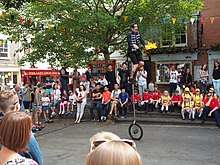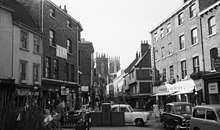King's Square (York)
King's Square is an open area in the city centre of York, in England.

History
In the Roman period, the south-eastern gate of Eboracum lay on the site of what is now King's Square. This was built in about 108, as recorded on a surviving inscription, now in the Yorkshire Museum.[1] The area was mentioned by Egil Skallagrimsson in the 10th-century as "Konungsgarthr", and this has led to a belief that this was the location of the royal palace of the Danelaw, and possibly of its predecessors, the Kingdom of Northumbria and the Kingdom of Deira. By 1430, the west side of the square was occupied by a row of mercer's shops, with a building named "Hellekeld" to their south. In 1627, Duke Gill Hall lay on the north-east side of the square, on its corner with St Andrewgate, and it was recorded that the hall was formerly known as "the King's Court".[2]
Until the 18th-century, the square covered only a small area, and was often regarded as the southernmost part of Low Petergate, immediately north of the churchyard of Holy Trinity, King's Court. The churchyard was reduced on several occasions, and from 1780 the area became known as "King's Square". In 1937, the church itself was demolished, and the square reached its current extent. 19 of the remaining gravestones were used to pave part of the square, although many are now illegible. The square absorbed the northern part of Colliergate and the whole of the street of King's Court, although those street names are retained by the properties on the extended section of the square. Some Mediaeval buildings on King's Court were demolished as late as the 1950s.[1][2]

In 2013, the City of York Council spent £490,000 renovating the square. It is popular with tourists, who are often entertained by buskers and street performers.[3] Nikolaus Pevsner notes that "the square has trees, which distinguishes it".[4] The York's Chocolate Story attraction lies on the western side of the square.[5]
Architecture and layout
The square is triangular in shape. From its northern point, Low Petergate leads north-west, Church Street to the south-west, and Goodramgate to the north-east. From its south-western point, Newgate leads west, and The Shambles to the south, while from the south-eastern point, Colliergate leads south. St Andrewgate runs north-east from the middle of the north-east side of the square.[2]
On the south-west side, number 5 King's Square was built in 1587 by Richard Hutton, while 4 King's Court is 15th-century, but was rebuilt in 1963. Pump Court is also Mediaeval in origin, but was largely rebuilt in 1755, and again in and 1951. In between is Refuge House, built in 1963. On the south-east side is St Trinity House, which was originally three houses hidden behind the church, dating from the 15th-century or earlier. On the north-east side, 2 King's Court is an early-19th century shop.[2][4][6]
References
- A History of the County of York: the City of York. London: Victoria County History. 1961. Retrieved 7 August 2020.
- An Inventory of the Historical Monuments in City of York, Volume 5, Central. London: HMSO. 1981. Retrieved 7 August 2020.
- Liptrot, Kate (3 April 2013). "£490k makeover for King's Square in York". The Press. Retrieved 13 August 2020.
- Pevsner, Nikolaus (1995). Yorkshire: York and the East Riding. Yale University Press. pp. 221–222. ISBN 0300095937.
- Williers, Daniel (3 August 2020). "We're Backing York: Chocolate Story reopening is success". The Press. Retrieved 13 August 2020.
- Historic England. "St Trinity House (1257520)". National Heritage List for England. Retrieved 13 August 2020.